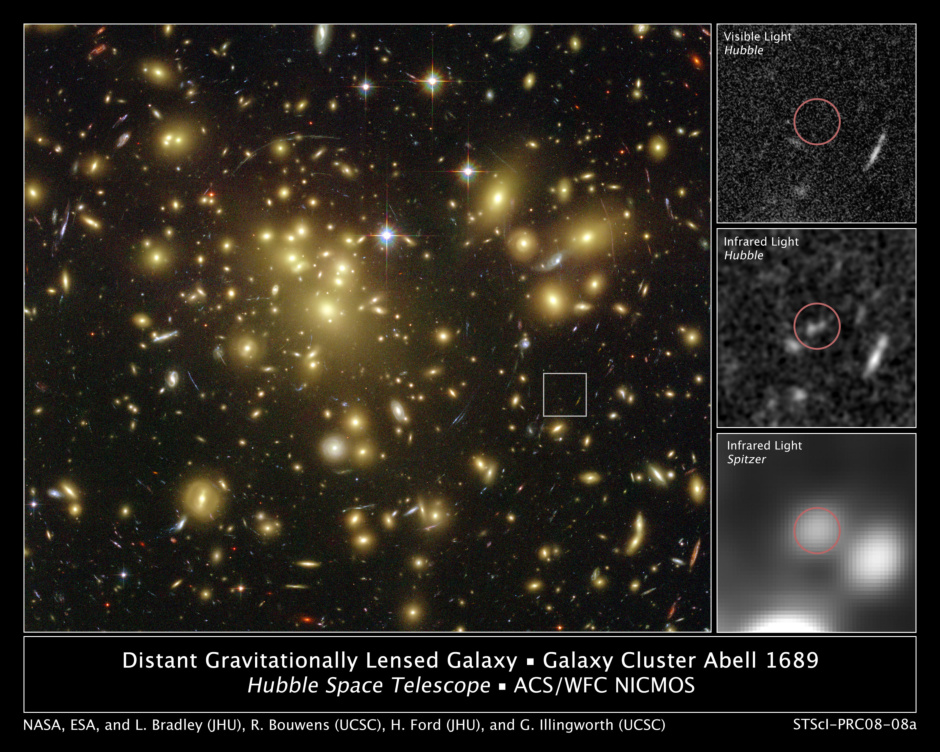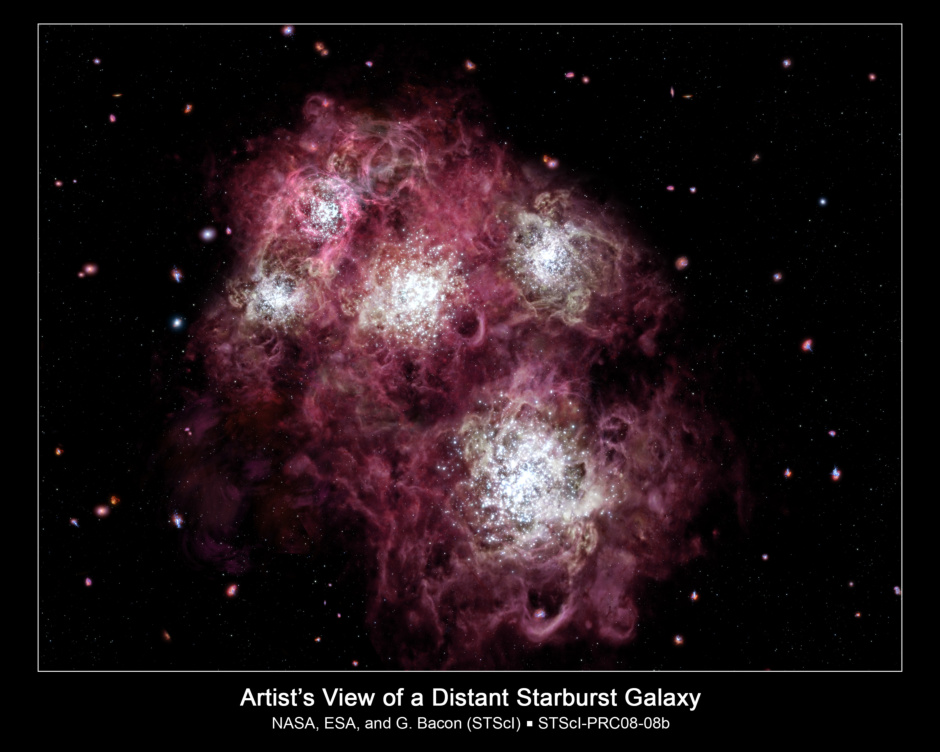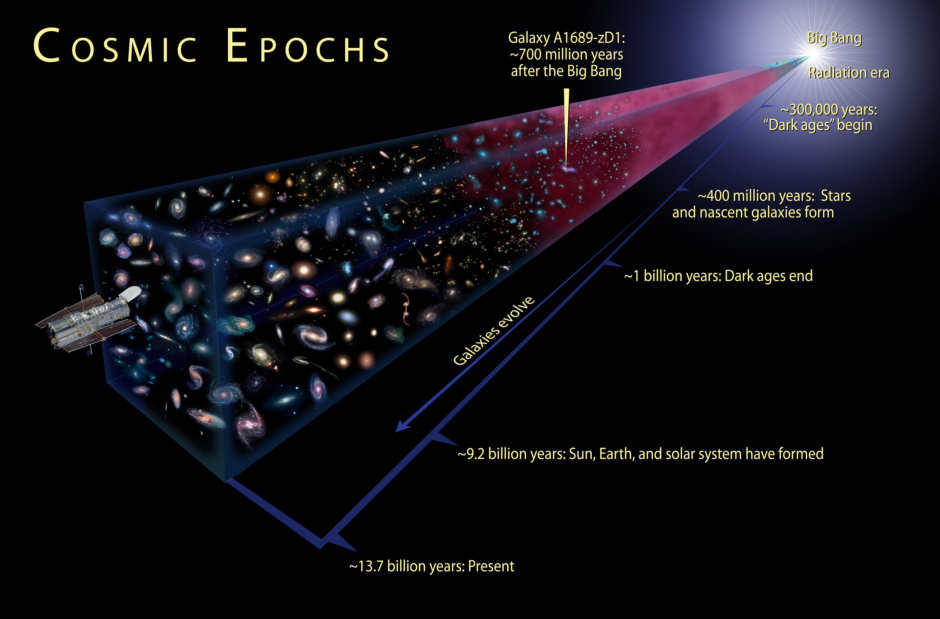허블 우주망원경과 스피처 우주망원경이 중력렌즈 현상을 통해 지금까지 관측된 은하들 중 가장 어린 나이이면서 가장 밝은 은하를 발견했다.
이 은하는 우리 우주가 탄생된 후 7억년이 갓 지난 시점인 '암흑시대'의 우주에서 관측된 것이다.
허블 우주망원경의 NICMOS(근적외선 카메라와 다중객체분광계, Near Infrared Camera and Multi-Object Spectrometer)에 의해 촬영된 이 정밀한 사진은, 빅뱅이 발생한 직후, 그러나 아직은 첫번째 별이 탄생하여 차갑고 어두운 우주를 재가열하기 직전에 새로운 별들을 만들기 위한 폭풍이 지속되고 있는 A1689-zD1 이라 명명된 어린은하를 보여주고 있다.
이 은하가 새로운 별들의 형성이 진행되고 있는 암흑기 우주에 해당하는 은하라는 강력한 추가 증거가 스피처 우주망원경의 적외선 카메라 사진을 통해 제공되었다.
이번 연구에 참여한 캘리포니아 대학의 천문학자 가스 일링워드(Garth Illingworth)는 이처럼 밝은 은하가 128억년 전의 은하라는 사실에 놀라지 않을 수 없었다고 말했다.
또한 이 은하의 공동 발견자 중 한 명인 캘리포니아 대학의 천문학자 리처드 보웬스(Rychard Bouwens)는
"이 사진은 이처럼 멀리 떨어진 과거의 천체 관측 자료중 가장 상세한 자료입니다. 허블이 촬영한 이미지는 이 은하의 구조까지도 보여주고 있는데 다른 관측기로는 어림도 없는 일입니다." 라고 덧붙였다.
이 사진은 은하가 탄생과 진화를 겪는 시기에 대한 통찰력을 제공해 줄 것이며 우주의 암흑기에 종말을 장식했을 천체들의 유형에 대한 정보도 제공해 줄 것이다.
또한 이처럼 멀리 떨어진 은하는 허블 우주 망원경의 후계자이며, 2013년에 발사예정인 제임스 웹 우주 망원경(the James Webb Space Telescope,JWST)의 이상적인 관측목표가 될 것이다.
일생동안, 우주의 머나먼 과거를 엿본 허블 우주 망원경은 진화의 초기 단계에 있는 은하를 지속적으로 관측해왔다.
이번 관측을 통해 얻어진 일련의 사진들은 천문학자들이 어린 아기로부터 어른으로 성장해가는 은하들의 스크랩북을 만드는데 도움이 되고있다.
허블과 스피처에 의해 촬영된 A1689-zD1 사진은 은하들의 유아기 시절을 보여주고 있다.
현재의 이론은 우주의 암흑기가, 우주의 팽창으로 인해 우주의 구성 물질들이 충분히 식어서, 차가운 수소 구름을 형성하기 시작한 빅뱅 후 40만년 후부터 시작된 것이라는 입장을 견지하고 있다.
이 차가운 소수 구름들은 마치 짙은 안개처럼 우주 전역을 뒤덮고 있었다. 이 시기에 있어 주목할 점은 별과 은하들이 이 때부터 형성되기 시작했다는 것이다.
수소구름들이 뭉쳐 빛을 발산하기 시작하면서 차가운 수소로 구성된 안개를 가열하기 시작한 때가 빅뱅 후 10억년이 지난 암흑기의 종말이었다.
우주 암흑기의 종말에 대해 이번 연구를 이끈 존스 홉킨스 대학의 천문학자인 레리 브레들리는 다음과 같이 말하고 있다.
"아마 이 은하는 우주 암흑기의 종말을 이끈 수많은 은하들 중 하나일 것입니다. 천문학자들은 퀘이사와 같은 고에너지 천체들이 우주의 암흑기를 끝내기에는 충분한 에너지를 가지고 있지 않다는 점에 확실히 동의하고 있습니다. 그러나 수없이 많은 어린 별들을 만들어내는 은하들이라면 우주의 암흑기에 종말을 가져다 줄 충분한 에너지를 만들 수 있습니다."
너무 멀리 떨어져 있는 이 은하는 허블 ACS(Advanced Camera for Surveys)가 촬영한 사진에는 나타나 있지 않은데 그 이유는 이 은하로부터 출발한 빛이 우주의 팽창에 의해 파장이 늘어나면서 눈에 보이지 않는 적외선 파장으로 변했기 때문이다.
이렇게 변환된 적외선이 허블이 NICMOS와 스피처 우주망원경, 그리고 중력렌즈라 불리는 자연이 제공해주는 기술로 인해 포착되면서 멀리 떨어진 이 은하를 볼 수 있게 된 것이다.
천문학자들은 22억 광년 거리에 있는 Abell 1689라고 알려진 거대한 질량의 은하단을 통해 그 뒷쪽 직선 방향으로 멀리 떨어진 은하들의 확대되어 나타난 빛을 관측하였다. 이처럼 자연현상이 만들어준 망원경을 '중력 렌즈'라 부른다.
비록 멀리 떨어진 천체들의 희미한 빛은 거의 관측하기 불가능하지만, 중력 렌즈 현상에 의해 그 밝기가 거의 10배 정도로 강해지기 때문에 허블과 스피처 우주망원경이 이를 관측할 수 있었던 것이다.
중력렌즈효과로 나타난 이 은하의 존재는, 은하단의 중력간섭 효과로 공간이 휘어지면서 Abell 1689 뒷편에 아치모양으로 사진에 덧붙여져 나타났다.
이 사진을 통해 거대한 질량을 가진 수백만개의 별들이 빽빽하게 무리지어 있는 이 은하의 특정지역을 볼 수 있는데 그 길이는 약 2천광년으로서 우리 은하의 너비와 비교할 때 일부분에 지나지 않는다.
브레들리와 일링워스는 별들이 새로 형성되기 시작했던 초기 우주에서 이러한 유형의 은하는 오늘날 은하들에서 볼 수 있는 일반적인 유형은 아니라고 말했다.
그러나 스피처 우주망원경이 촬영한 이 이미지는 이러한 은하의 규모가 초기 우주에서는 은하의 전형적인 형태임을 보여주고 있다.
그 질량은 우리 태양과 같은 별의 수십억배에 대응되는 질량인데 이는 우리 은하와 비교했을 때는 극히 일부분에 지나지 않는 질량이다.
일링워드는 이번 관측은 요즘 관측되는 은하와 비교할 때 최초 별들의 탄생이 매우 협소한 지역에서 발생하기 시작했다는 이전 허블의 연구결과를 확증하고 있다고 말했다.
중력렌즈 효과에 의해 그 상이 확대되어 보이긴 하지만 은하에서 가장 무거운 별들이라 하더라도 허블의 고분해능을 동원해서야 하나의 밝은 점만이 관측될 뿐이다.
따라서 밝기가 좀더 흐리거나, 작은 규모의 별들인 경우, 또는 개별적인 별들이나 별들이 탄생되는 지역을 둘러싼 물질들을 망원경을 통해 잡아내기에는 한계가 있다.
이러한 천체들을 관측하기 위해 천문학자들은 적외선 감지기능이 강화된 NASA의 제임스 웹 우주망원경(JWST)을 필요로 하게 될 것이다.
이 적외선 감지기는 허블 우주망원경의 주경보다 7배 큰 크기의 주경을 갖게될 것이며 따라서 더욱더 희미한 은하들로부터 발생한 빛을 잡아낼 수 있을 것이다.
JWST는 또한 더더욱 멀리 떨어진 은하들로부터 발생하여 파장이 적외선 영역에 깊이 밀려나 NICMOS의 대응범위를 벗어나는 빛들도 관측할 수 있게 된다.
연구팀의 일원인 존홉킨스 대학의 홀란드 포드는 이 은하가 제임스 웹 우주망원경이 관측하게 될 첫 번째 천체가 될 것이 확실하다고 말했다.
천문학자들은 또한 이 은하를 2012년에 완공될 ALMA(the Atacama Large Millimeter Array)의 이상적인 관측대상으로 점찍고 있는데, ALMA는 완공될 경우 세계 최고의 성능을 가진 라디오 전파 망원경이 될 것이다.
일링워드는 "ALMA와 JWST의 협동관측자료를 통해 이 은하에 대한 진정한 이해가 이루어질 것입니다.
JWST가 이미지를 제공하고 ALMA가 가스의 측정자료를 제공하면 초기 은하에 대한 획기적인 통찰이 이루어질 것입니다."라고 말했다.
천문학자들은 이 은하까지의 거리를 확정하기 위해 하와이 마우나 케아의 정상에 위치한 켁 천문대의 적외선 분광자료를 통한 연구를 진행하게 될 것이다.
연구 결과는 Astrophysical Journal에 개제될 예정이다.
그림설명1> 이 그림은 빅뱅이 발생한 후 10억년이 지나지 않은 초기 우주에서 새로운 별들을 만들어내고 있는 원시 은하에 대한 상상도이다.
이 은하는 아직 형성이 진행되고 있는 은하로서 우리 은하 주변에서 볼 수 있는 장대한 나선은하 또는 타원형 은하와는 아주 다른 모습을 띄고 있다.
이 그림에는 새로운 삶을 시작하는 몇몇 성단 덩어리들이 묘사되어 있다.
이들은 초신성과 같은 거대한 별들이 폭발하면서 분출해낸 수소가스가 불타면서 형성된 거대한 거품에 싸여 있다.
배경으로 보이는 은하들 역시 은하로 성장해 가고 있는 어린 은하들이다.
허블과 스피처가 발견해낸 어린 은하는 이 그림에 묘사된 것과 같은 은하로서 빅뱅 후 7억년이 지난 시점에 탄생한 은하이다.
그림설명2> 허블이 촬영한 우주연대 상상도
오른쪽 상단부터
1. Big Bang : 빅뱅
2. Radiation Era : 복사에너지 시기
3. ~ 300,000 Years : "Dark Ages" begin - 30만년까지 : 암흑기 시작
4. ~ 400 million years : Start and nascent galaxies form : ~ 4억년 : 별과 원시은하의 형성
5. ~ 1 billion years : Dark ages end - ~ 10억년 : 암흑기 종료
6. ~ 9.2 billion years : Sun, Earth, and solar system have formed ~ 92억년 : 태양, 지구, 태양계의 형성
7. ~ 13.7 billion years : Present
이번에 발견된 은하인 A1689-zD1은 빅뱅 7억년 후의 은하로서 상단에 표시되어 있음.
* '허블사이트'의 게시물들은 허블사이트 http://hubblesite.org 의 뉴스센터 자료들을 번역한 자료들입니다.
본 내용은 2008년 2월 12일 발표된 뉴스입니다.
원문>
FULL STORY>
NASA's Hubble and Spitzer space telescopes, with a boost from a natural "zoom lens," have uncovered what may be one of the youngest and brightest galaxies ever seen in the middle of the cosmic "dark ages," just 700 million years after the beginning of our universe.
The detailed images from Hubble's Near Infrared Camera and Multi-Object Spectrometer (NICMOS) reveal an infant galaxy, dubbed A1689-zD1, undergoing a firestorm of star birth during the dark ages, a time shortly after the Big Bang but before the first stars reheated the cold, dark universe. Images from NASA's Spitzer Space Telescope's Infrared Array Camera provided strong additional evidence that it was a young star- forming galaxy in the dark ages.
"We certainly were surprised to find such a bright young galaxy 12.8 billion years in the past," said astronomer Garth Illingworth of the University of California, Santa Cruz, and a member of the research team. "This is the most detailed look to date at an object so far back in time."
"The Hubble images yield insight into the galaxy's structure that we cannot get with any other telescope," added astronomer Rychard Bouwens of the University of California, Santa Cruz, one of the co-discoverers of this galaxy.
The new images should offer insights into the formative years of galaxy birth and evolution and yield information on the types of objects that may have contributed to ending the dark ages. The faraway galaxy also is an ideal target for Hubble's successor, the James Webb Space Telescope (JWST), scheduled to launch in 2013.
During its lifetime, the Hubble telescope has peered ever farther back in time, viewing galaxies at successively younger stages of evolution. These snapshots have helped astronomers create a scrapbook of galaxies from infancy to adulthood. The new Hubble and Spitzer images of A1689-zD1 show a time when galaxies were in their infancy.
Current theory holds that the dark ages began about 400,000 years after the Big Bang, as matter in the expanding universe cooled and formed clouds of cold hydrogen. These cold clouds pervaded the universe like a thick fog.
At some point during this era, stars and galaxies started to form. Their collective light reheated the foggy, cold hydrogen, ending the dark ages about a billion years after the Big Bang.
"This galaxy presumably is one of the many galaxies that helped end the dark ages," said astronomer Larry Bradley of Johns Hopkins University in Baltimore, Md., and leader of the study. "Astronomers are fairly certain that high-energy objects such as quasars did not provide enough energy to end the dark ages of the universe. But many young star- forming galaxies may have produced enough energy to end it."
The galaxy is so far away it did not appear in images taken with Hubble's Advanced Camera for Surveys, because its light is stretched to invisible infrared wavelengths by the universe's expansion. It took Hubble's NICMOS, Spitzer, and a trick of nature called gravitational lensing to see the faraway galaxy.
The astronomers used a relatively nearby massive cluster of galaxies known as Abell 1689, roughly 2.2 billion light-years away, to magnify the light from the more distant galaxy directly behind it. This natural telescope is called a gravitational lens.
Though the diffuse light of the faraway object is nearly impossible to see, gravitational lensing has increased its brightness by nearly 10 times, making it bright enough for Hubble and Spitzer to detect. A telltale sign of the lensing is the smearing of the images of galaxies behind Abell 1689 into arcs by the gravitational warping of space by the intervening galaxy cluster.
The images reveal bright, dense clumps of hundreds of millions of massive stars in a compact region about 2,000 light-years across, which is only a fraction of the width of our Milky Way Galaxy. This type of galaxy is not uncommon in the early universe, when the bulk of star formation was taking place, Bradley and Illingworth said.
Spitzer's images show that the galaxy's mass is typical to that of galaxies in the early universe. Its mass is equivalent to several billions of stars like our Sun, or just a tiny fraction of the mass of the Milky Way.
"This observation confirms previous Hubble studies that star birth happens in very tiny regions compared with the size of the final galaxy," Illingworth said.
Even with the increased magnification from the gravitational lens, Hubble's sharp "eye" can only see knots of the brightest, heftiest stars in the galaxy. The telescope cannot pinpoint fainter, lower-mass stars, individual stars, or the material surrounding the star- birthing region. To see those things, astronomers will need the infrared capabilities of NASA's JWST. The planned infrared observatory will have a mirror about seven times the area of Hubble's primary mirror and will collect more light from faint galaxies. JWST also will be able to view even more remote galaxies whose light has been stretched deep into infrared wavelengths that are out of the reach of NICMOS.
"This galaxy will certainly be one of the first objects that will be observed by JWST," said team member Holland Ford of Johns Hopkins University. "This galaxy is so bright that JWST will see its detailed structure. This object is a pathfinder for JWST for deciphering what is happening in young galaxies."
The astronomers noted that the faraway galaxy also would be an ideal target for the Atacama Large Millimeter Array (ALMA), which, when completed in 2012, will be the most powerful radio telescope in the world. "ALMA and JWST working together would be an ideal combination to really understand this galaxy," Illingworth said, noting that "JWST's images and ALMA's measurement of the gas motions will provide revolutionary insights into the very youngest galaxies."
The astronomers will conduct follow-up observations with infrared spectroscopy to confirm the galaxy's distance using the Keck telescope atop Mauna Kea in Hawaii.
The results will be published in the Astrophysical Journal.
CONTACT
Donna Weaver/Ray Villard
Space Telescope Science Institute, Baltimore, Md.
410-338-4493/4514
dweaver@stsci.edu/villard@stsci.edu
Larry Bradley
Johns Hopkins University, Baltimore, Md.
410-516-5108
ldb@pha.jhu.edu
Garth Ilingworth
University of California Observatories/Lick Obs./University of California, Santa Cruz, Calif.
831-459-2843
gdi@ucolick.org
그림설명 1>
This is an artist's impression of an embryonic galaxy brimming with star birth in the early universe, less than a billion years after the Big Bang. The galaxy is still forming and looks nothing like the majestic spiral and elliptical galaxies that are neighbors of our Milky Way Galaxy.
The illustration shows several tight clusters of stars bursting to life. They are surrounded by glowing bubbles of hydrogen gas produced by massive stars erupting as supernovae. A tapestry of young, developing galaxies is in the background.
The Hubble and Spitzer space telescopes discovered a young star-forming galaxy like the one in this illustration. The galaxy spied by Hubble and Spitzer was born just 700 million years after the Big Bang.
Image Type: Artwork
Credit: NASA, ESA, and G. Bacon (Space Telescope Science Institute)
'3. 천문뉴스 > 허블사이트' 카테고리의 다른 글
| GRB 080319B (0) | 2008.04.20 |
|---|---|
| NGC 2371 (0) | 2008.03.07 |
| NGC 1132 (0) | 2008.02.07 |
| NGC 602, N90 (0) | 2008.01.28 |
| 목성 대기의 폭풍 (0) | 2008.01.28 |


